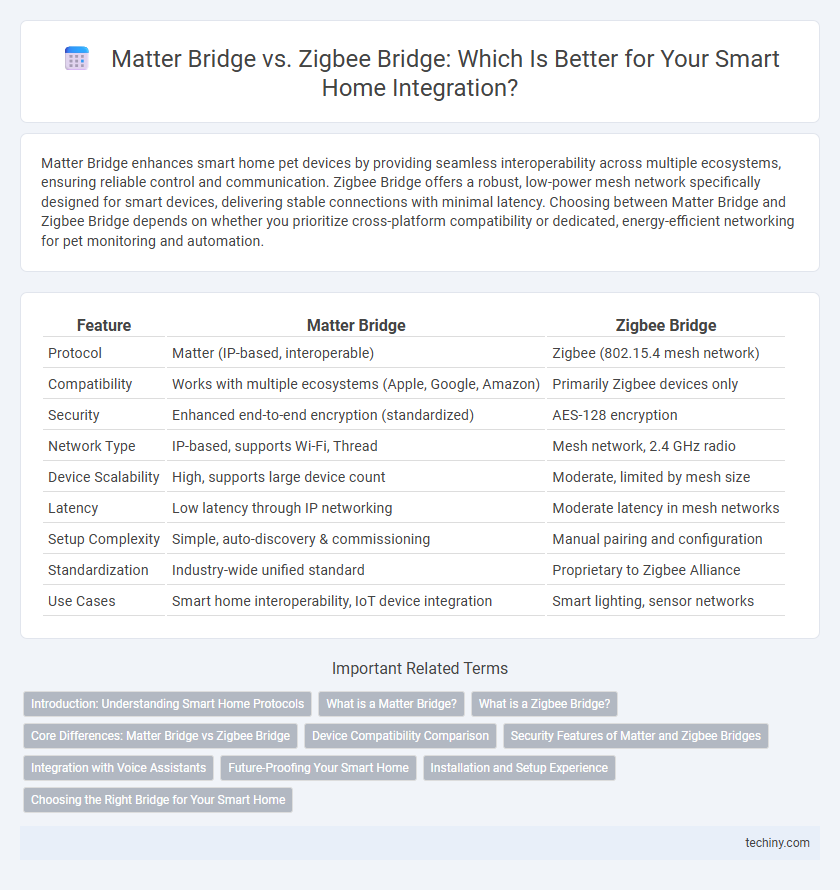Matter Bridge enhances smart home pet devices by providing seamless interoperability across multiple ecosystems, ensuring reliable control and communication. Zigbee Bridge offers a robust, low-power mesh network specifically designed for smart devices, delivering stable connections with minimal latency. Choosing between Matter Bridge and Zigbee Bridge depends on whether you prioritize cross-platform compatibility or dedicated, energy-efficient networking for pet monitoring and automation.
Table of Comparison
| Feature | Matter Bridge | Zigbee Bridge |
|---|---|---|
| Protocol | Matter (IP-based, interoperable) | Zigbee (802.15.4 mesh network) |
| Compatibility | Works with multiple ecosystems (Apple, Google, Amazon) | Primarily Zigbee devices only |
| Security | Enhanced end-to-end encryption (standardized) | AES-128 encryption |
| Network Type | IP-based, supports Wi-Fi, Thread | Mesh network, 2.4 GHz radio |
| Device Scalability | High, supports large device count | Moderate, limited by mesh size |
| Latency | Low latency through IP networking | Moderate latency in mesh networks |
| Setup Complexity | Simple, auto-discovery & commissioning | Manual pairing and configuration |
| Standardization | Industry-wide unified standard | Proprietary to Zigbee Alliance |
| Use Cases | Smart home interoperability, IoT device integration | Smart lighting, sensor networks |
Introduction: Understanding Smart Home Protocols
Matter Bridge and Zigbee Bridge serve as essential hubs connecting various smart devices within a home ecosystem. Matter, a recent industry-unified standard, offers enhanced interoperability across brands by supporting IP-based communication, while Zigbee relies on a mesh network protocol popular for low-power, reliable device connections. Understanding these protocols helps homeowners choose the right bridge for seamless control and integration of smart home devices.
What is a Matter Bridge?
A Matter Bridge is a device that enables seamless communication between Matter-compatible smart home devices and other ecosystems or protocols, acting as a universal translator to enhance interoperability. Unlike Zigbee Bridges, which connect exclusively Zigbee devices to a smart home network, Matter Bridges support multiple protocols including IP-based connectivity for broader device compatibility. This technology streamlines device management and improves reliability by leveraging the open-source, royalty-free Matter standard developed by the Connectivity Standards Alliance.
What is a Zigbee Bridge?
A Zigbee Bridge acts as a central hub connecting Zigbee-enabled smart devices to a home network, enabling seamless communication and control via apps or voice assistants. It operates on the Zigbee wireless protocol, known for low power consumption and reliable mesh networking among devices like smart bulbs, sensors, and locks. Unlike a Matter Bridge, which supports multiple protocols for broader compatibility, a Zigbee Bridge specializes in managing Zigbee devices exclusively within smart home ecosystems.
Core Differences: Matter Bridge vs Zigbee Bridge
Matter Bridge offers enhanced interoperability by supporting a unified IP-based protocol that simplifies connectivity across diverse smart home devices, while Zigbee Bridge relies on a proprietary mesh network optimized for low-power, local device communication. Matter Bridge prioritizes seamless integration with major cloud platforms and IP ecosystems, enabling easier device control and firmware updates, whereas Zigbee Bridge excels in established, industry-proven reliability within closed network environments. Core differences lie in Matter's emphasis on universal compatibility and internet-based communication versus Zigbee's focus on efficient, localized device networking.
Device Compatibility Comparison
Matter Bridge offers broad device compatibility across multiple brands and ecosystems, enabling seamless connectivity between smart home products regardless of manufacturer. Zigbee Bridge primarily supports Zigbee-certified devices, which limits interoperability to the Zigbee standard but ensures robust, low-power communication within its network. Choosing between them depends on whether you prioritize cross-protocol integration with Matter or the mature, device-specific ecosystem of Zigbee.
Security Features of Matter and Zigbee Bridges
Matter Bridges leverage robust end-to-end encryption and decentralized device authentication, significantly enhancing protection against unauthorized access in smart home networks. Zigbee Bridges utilize network-layer security with AES-128 encryption and trust center mechanisms, but may be more vulnerable to centralized attacks due to their reliance on a single coordinator. Matter's advanced security framework integrates seamless updates and device attestation, strengthening overall system integrity beyond traditional Zigbee Bridge capabilities.
Integration with Voice Assistants
Matter Bridge offers seamless integration with major voice assistants like Amazon Alexa, Google Assistant, and Apple Siri, enabling unified control across diverse smart home devices. Zigbee Bridge supports voice assistant compatibility but often requires additional hubs or apps for full functionality, limiting direct control. Matter's standardized protocol enhances interoperability and simplifies voice command execution in complex smart home ecosystems.
Future-Proofing Your Smart Home
Matter Bridge offers enhanced interoperability by supporting multiple smart home protocols, ensuring devices from various brands work seamlessly together, which future-proofs your smart home ecosystem. Zigbee Bridge, while reliable and widely adopted, is limited to Zigbee devices, potentially requiring additional hubs as new standards emerge. Investing in a Matter Bridge aligns with industry trends toward unified connectivity, reducing complexity and increasing long-term compatibility for smart home networks.
Installation and Setup Experience
Matter Bridge offers a streamlined installation process with native IP networking, reducing reliance on proprietary hubs and enabling quicker device onboarding via standard protocols. Zigbee Bridge requires pairing through a dedicated hub, often involving proprietary apps and firmware updates that can extend setup time and complexity. Both solutions support integration with smart home ecosystems, but Matter Bridge prioritizes ease and future-proof interoperability with minimal configuration steps.
Choosing the Right Bridge for Your Smart Home
Choosing the right bridge for your smart home depends on device compatibility and network requirements. Matter Bridge supports a wide range of manufacturers with seamless interoperability, making it ideal for future-proofing your ecosystem. Zigbee Bridge excels in low-power, mesh-network environments, providing reliable connectivity for numerous devices within a localized area.
Matter Bridge vs Zigbee Bridge Infographic

 techiny.com
techiny.com